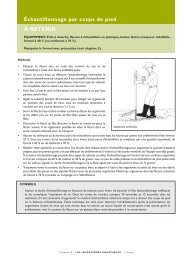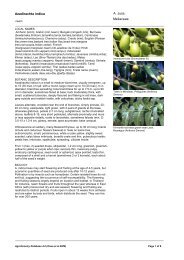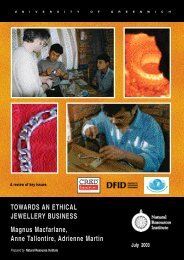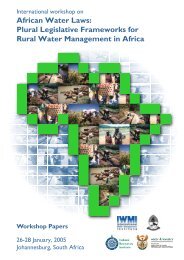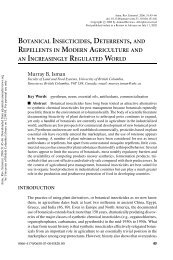Meteorological methods: temperature; humidity; rainfall; wind speed
Meteorological methods: temperature; humidity; rainfall; wind speed
Meteorological methods: temperature; humidity; rainfall; wind speed
Create successful ePaper yourself
Turn your PDF publications into a flip-book with our unique Google optimized e-Paper software.
M e a s u rement of curre n t<br />
DON’T FORGET<br />
EQUIPMENT: Gessner tube; spare plastic bags and rubber bands; plastic measuring<br />
cylinder (250 ml) or flow meter; orange; two stakes (2 m length); h a m m e r; 25 m tap e<br />
measure.<br />
Measurement of flow using a floating object is imprecise by comparison with the other<br />
<strong>methods</strong>.<br />
CURRENT SPEED BY FLOATING OBJECT<br />
Method<br />
• Place two stakes in the river and measure the distance between them. Throw in an orange or other<br />
heavy, floating object and time its unimpeded travel between the two points. Repeat 2–3 times to<br />
obtain an average surface flow rate in m s -1<br />
flow rate (m s -1 ) = distance travelled by float (m)/time to cover distance (s).<br />
• Estimate river velocity (slower than surface velocity) by multiplying the average time by 0.8 before<br />
applying the equation above.This compensates for the drag caused by the river bed.<br />
CURRENT SPEED BY METER<br />
Method<br />
• Measure the depth of the water using a pole and then set the propeller depth on the shaft at a<br />
distance of one-third of the depth – measuring from the foot of the shaft. Point the propeller of a<br />
current meter upstream and record the number of turns logged after 30 s. Repeat several times,<br />
read off the current <strong>speed</strong> from the supplied calibration graph or a factor provided with the<br />
instrument, and average the result. Repeat at various depths if the river is deep enough to warrant<br />
a velocity profile.<br />
• For estimating flow rate through a drift net, place the propeller at the mouth of the net.Take readings<br />
at the beginning and end of the drift sampling period, e.g. at time zero and 4 h. Calculate the average<br />
current through the net. (Custom-built meters that fit<br />
into the mouth of a drift net will integrate the variable<br />
flow through the net as the latter clogs up and impedes<br />
flow. This method is the preferred but expensive<br />
option.)<br />
Flow meter<br />
Pole or shaft<br />
CURRENT SPEED/VOLUME BY GESSNER TUBE<br />
Method<br />
• Close the funnel aperture with a finger and place the<br />
tube, funnel upstream, into the water. Remove finger<br />
for a few seconds to allow the water to flow into the<br />
tube before closing the aperture again. Remove the<br />
tube and measure the volume of water in the bag by<br />
pouring into a measuring cylinder. Repeat twice and<br />
at various depths if feasible. Calculate the flow rate<br />
from the formula:<br />
flow (cm-2 s-1 ) = volume of water trapped (ml)/time (s)<br />
x cross-sectional area of opening (π r2 )<br />
flow volume (cm3 cm-2 s -1 (r<br />
) = (volume in ml/π ) x<br />
2 )/time (s).<br />
Cable to meter<br />
Depth<br />
Current<br />
Propeller<br />
Chapter 5 E N V I R O N M E N TA L PA R A M E T E R S I. Grant<br />
2 ⁄3 from surface<br />
Bed<br />
Foot



